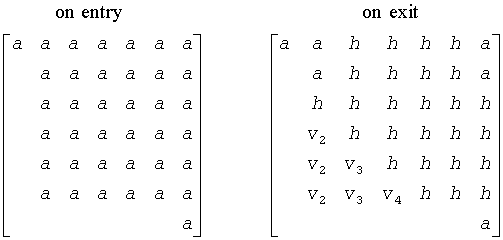Developer Reference for Intel® oneAPI Math Kernel Library for Fortran
A newer version of this document is available. Customers should click here to go to the newest version.
Visible to Intel only — GUID: GUID-646F2BAE-6D33-4114-B167-B731ED52CCB8
Visible to Intel only — GUID: GUID-646F2BAE-6D33-4114-B167-B731ED52CCB8
?gehd2
Reduces a general square matrix to upper Hessenberg form using an unblocked algorithm.
Syntax
call sgehd2( n, ilo, ihi, a, lda, tau, work, info )
call dgehd2( n, ilo, ihi, a, lda, tau, work, info )
call cgehd2( n, ilo, ihi, a, lda, tau, work, info )
call zgehd2( n, ilo, ihi, a, lda, tau, work, info )
Include Files
- mkl.fi
Description
The routine reduces a real/complex general matrix A to upper Hessenberg form H by an orthogonal or unitary similarity transformation QT*A*Q = H (for real flavors) or QH*A*Q = H (for complex flavors).
The routine does not form the matrix Q explicitly. Instead, Q is represented as a product of elementary reflectors.
Input Parameters
- n
-
INTEGER The order of the matrix A (n≥ 0).
- ilo, ihi
-
INTEGER. It is assumed that A is already upper triangular in rows and columns 1:ilo -1 and ihi+1:n.
If A has been output by ?gebal, then
ilo and ihi must contain the values returned by that routine. Otherwise they should be set to ilo = 1 and ihi = n. Constraint: 1 ≤ ilo ≤ ihi ≤ max(1, n).
- a, work
-
REAL for sgehd2
DOUBLE PRECISION for dgehd2
COMPLEX for cgehd2
DOUBLE COMPLEX for zgehd2.
Arrays:
a (lda,*) contains the n-by-n matrix A to be reduced. The second dimension of a must be at least max(1, n).
work (n) is a workspace array.
- lda
-
INTEGER. The leading dimension of a; at least max(1, n).
Output Parameters
- a
-
On exit, the upper triangle and the first subdiagonal of A are overwritten with the upper Hessenberg matrix H and the elements below the first subdiagonal, with the array tau, represent the orthogonal/unitary matrix Q as a product of elementary reflectors. See Application Notes below.
- tau
-
REAL for sgehd2
DOUBLE PRECISION for dgehd2
COMPLEX for cgehd2
DOUBLE COMPLEX for zgehd2.
Array, DIMENSION at least max (1, n-1).
Contains the scalar factors of elementary reflectors. See Application Notes below.
- info
-
INTEGER.
If info = 0, the execution is successful.
If info = -i, the i-th parameter had an illegal value.
Application Notes
The matrix Q is represented as a product of (ihi - ilo) elementary reflectors
Q = H(ilo)*H(ilo +1)*...*H(ihi -1)
Each H(i) has the form
H(i) = I - tau*v*vT for real flavors, or
H(i) = I - tau*v*vH for complex flavors
where tau is a real/complex scalar, and v is a real/complex vector with v(1:i) = 0, v(i+1) = 1 and v(ihi+1:n) = 0.
On exit, v(i+2:ihi) is stored in a(i+2:ihi, i) and tau in tau(i).
The contents of a are illustrated by the following example, with n = 7, ilo = 2 and ihi = 6:

where a denotes an element of the original matrix A, h denotes a modified element of the upper Hessenberg matrix H, and vi denotes an element of the vector defining H(i).